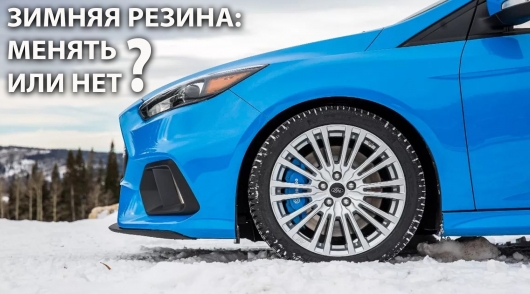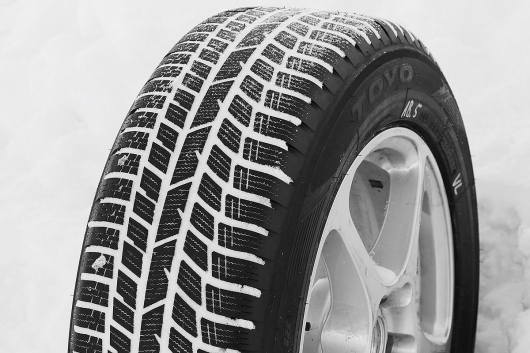Winter tires: when it’s time to change
That’s when it’s time to change summer tires for winter.

Any motorist who drives his car in winter weather on summer tyres, risking his safety, the safety of their passengers, and endanger other road users. Is there a fine for driving on summer tires in winter, when the law drivers need to change tires, and how to determine when it’s time to put the snow tires? We have the answers to these and other issues of concern to the millions of car owners before the winter period.
Every year at the first frost of the drivers a headache at the tire change from summer to winter. All drivers know about the need to use winter tires, but every year hundreds of thousands of drivers begin to ask yourself the question: when you need to change tires?
 Moreover, this issue concerns even those drivers who in their lives have changed tires before the winter period already twenty times. Also many drivers hear about the first frost, begin to look for information online to better know whether the time has come to change the car to winter tires.
Moreover, this issue concerns even those drivers who in their lives have changed tires before the winter period already twenty times. Also many drivers hear about the first frost, begin to look for information online to better know whether the time has come to change the car to winter tires.
But why such a mess with winter tires? Is there no exact date when to send the summer tires on the balcony?
Despite the fact that the law is one document, which is strictly reglementary the use of winter tires on the car, in fact there is no exact date when all car owners in Russia are obliged to change summer tires for winter.
The fact that the replacement time of the tire depends on the weather conditions of the region of operation of the vehicle. Logically, in the Northern regions of Russia motorists begin to change tires in September, while in southern mass replacement rubber starts towards the end of November.
 What the law says? In Russia currently valid technical regulations of the Customs Union TR CU 018/2011 “On safety of wheeled vehicles”, which clearly explains when it is forbidden to use as summer tires and winter.
What the law says? In Russia currently valid technical regulations of the Customs Union TR CU 018/2011 “On safety of wheeled vehicles”, which clearly explains when it is forbidden to use as summer tires and winter.
This is governed by paragraph 5.5 of the Annex to technical regulation No. 8.
Thus, paragraph 5.5 describes the requirement for tyres and wheels in service on the territory of the Customs Union. Here is the paragraph of the technical regulations:
5.5. Prohibited operation of vehicles with studded tyres snow in summer (June, July, August).
Do not operate vehicles not equipped with winter tires that meet the requirements of paragraph 5.6.3. of this Annex during the winter season (December, January, February). Winter tires are mounted on all wheels of the vehicle.
The timing of prohibition of operation can be changed in the direction of increasing regional public administrations of member States of the Customs Union.
Now let’s for the sake of clarity let’s see what tyre should be used in the winter in December, January and February. To do this, refer to paragraph 5.6.3 of the technical regulations of the Customs Union:
5.6.3. Residual tread depth of winter tires designed for use on icy or snow-covered road surface, marked by a sign in the form of mountain tops with three peaks and a snowflake within it (figure 5.1), as well as signs marked “M+S”, “M&S”, “M S” (in the absence of wear indicators), during operation on the specified coverage – not more than 4.0 mm

As you can see, the use of rubber without marking sign in the form of mountain tops with three peaks and a snowflake within it, and in the absence of marking on the tyre of characters “M+S”, “M&S”, “M S” in the period from December to February (winter period) is prohibited.
Accordingly, according to the technical regulations drivers should not operate the car in December, January and February for summer tires.

By the way, according to this document, local authorities depending on weather conditions in the area have the right to extend the term of the ban on the use of summer and winter tires, and to reduce.
However, please note that ban the use of summer tyres in winter and Vice versa is regulated currently, only the technical regulations of the Customs Union.
Accordingly, violation of this regulation drivers are not facing any responsibility. Unfortunately, or for some fortunately, the penalty for using rubber is off-season in Russia yet. Recall that in the State Duma are currently several bills concerning the introduction of administrative liability for the use of summer tyres in winter and Vice versa. But a few years before these bills to our elected representatives do not care. So in the near future it is unlikely that the state Duma will adopt these laws.
However, despite the lack of administrative responsibility for driving the tires are not in season, we do not recommend to motorists to risk staying in winter on summer tires.
But when it is better to change summer tires for winter? When it really is time?

Each of us wants not to be mistaken by putting winter tires on time. Also every car enthusiast doesn’t want to change tires too early. Especially those who have a car equipped with studded tires. After all, if you change tires too early (when it’s still warm and no snow and ice), winter tires until the snow and freezing temperatures will wear faster.
Many believe that there is nothing to wrestle with, and every year changing tires, starting in October and exploiting it before Easter. Someone, on the contrary, stalling until the last and then stands there all day in the queue on the tire, when suddenly there was a sharp temperature drop or a lot of snow.
The behavior of nature, of course, to predict hard. You see, even the meteorologists are always wrong. October, by the way, in many regions of Russia in recent years is rather mild in temperature for a month. In the same year, September and October was generally much warmer the average.
With such weather to winter tires in late September – early October did not make sense in many regions of the country. The fact is that winter tires at temperatures over 7 degrees behaves not the best way. For example, at high temperatures, riding on snow tires increases fuel consumption and can adversely affect vehicle performance.

But also to bring to the past and not worth it. Because the weather can change in just a few hours. Therefore, every car owner must change my car to not be on summer tires on slippery icy road, where you will feel like a beginner skater on the ice. Remember that on summer tires in the winter, the car has poor adhesion with the road surface, causing braking distance grows. In some cases, the braking distance may not be.
In conclusion, in a traditional publication for our form, we decided to summarize our material in the form of questions and short answers.
FAQ on winter tires
Does the legal obligation to use winter tyres, and whether the fine for driving on summer tires in the winter?
 No, under current law the penalty for the use of rubber is off-season in Russia. However, in our country applies technical regulations of the Customs Union, which requires drivers in the period from December to February to use on the car winter tires.
No, under current law the penalty for the use of rubber is off-season in Russia. However, in our country applies technical regulations of the Customs Union, which requires drivers in the period from December to February to use on the car winter tires.
How to recognize winter tyres?
 There are two symbol of the winter tyre: the logo of M + S (indicating mud and snow) and Alpine symbol (mountain with snowflake).
There are two symbol of the winter tyre: the logo of M + S (indicating mud and snow) and Alpine symbol (mountain with snowflake).
What is the difference between winter tyres from summer?
 The composition of the rubber used in winter tires specifically designed for winter use. The rubber compound remains flexible even at low temperatures. At the same time, specially designed tread and spikes (if spike tires) winter tires allow you better engage in the snow and dirt with the road surface.
The composition of the rubber used in winter tires specifically designed for winter use. The rubber compound remains flexible even at low temperatures. At the same time, specially designed tread and spikes (if spike tires) winter tires allow you better engage in the snow and dirt with the road surface.
This not only improves manageability, but also significantly reduces braking distance. Therefore, winter tires provide in winter greater safety. There is a tread rubber with special grooves that disperse water and slush, which also improves the contact of tires with the road surface.
Can the insurance company refuse to pay damages if the car during an accident were the bus is not in season?
 As in SDA, the administrative code does not envisage a ban on the use of rubber is off-season, the insurance company may not refuse the victim in the accident to pay the damage. The refusal to pay in the CTP can only be the case if the driver convicted in the accident. Recall that guilty of the accident can be recognized in establishing the fact of violation of traffic rules and administrative code.
As in SDA, the administrative code does not envisage a ban on the use of rubber is off-season, the insurance company may not refuse the victim in the accident to pay the damage. The refusal to pay in the CTP can only be the case if the driver convicted in the accident. Recall that guilty of the accident can be recognized in establishing the fact of violation of traffic rules and administrative code.
Why the need for snow chains?
 In deep snow, winter tyres reach their limits. So if you drive in mountainous terrain (e.g. ski resort), I suggest you stock up just in case snow chains, in case of ice to put on winter tyres chains.
In deep snow, winter tyres reach their limits. So if you drive in mountainous terrain (e.g. ski resort), I suggest you stock up just in case snow chains, in case of ice to put on winter tyres chains.
How fast can you drive on winter tires?
 Like summer tires, winter tires also has an index of speed. A key indicator of this is the tyre size. Usually the speed is indicated on the rubber in Latin letters: mean Q max 160 km/h T 190 km/h H – 210 km/h V 240 km/h.
Like summer tires, winter tires also has an index of speed. A key indicator of this is the tyre size. Usually the speed is indicated on the rubber in Latin letters: mean Q max 160 km/h T 190 km/h H – 210 km/h V 240 km/h.
And don’t forget: physics has not been canceled. Even if you have installed the most expensive and the best winter tires. Therefore, despite the speed rating on your tires quickly in the winter, you will not be able to go because the ice and snow will not let you get too dispersed. Otherwise you risk to get into an accident.
What is the minimum tread depth for winter tyres?
 To find out what is the minimum tread depth allows the use of winter tyres on the car, let’s go again to the technical regulation of the Customs Union. So, according to the requirements of tires and wheels regulations of the Customs Union tyres are not suitable for use when:
To find out what is the minimum tread depth allows the use of winter tyres on the car, let’s go again to the technical regulation of the Customs Union. So, according to the requirements of tires and wheels regulations of the Customs Union tyres are not suitable for use when:
5.6.1. The emergence of one of the wear indicator (the projection of the bottom groove of the track, designed to provide a visual indication of the degree of wear, the depth of which corresponds to the minimum allowable tread depth of tyres);
5.6.2. Residual tread depth of the tyres (no wear indicators) is not more than:
- for vehicles of categories L – 0.8 mm;
- for vehicles of categories N2, N3, O3, O4 – 1,0 mm;
- for vehicles of categories M1, N1, O1, O2 – 1.6 mm;
- for vehicles of categories M2, M3 – 2.0 mm.
5.6.3. Residual tread depth of winter tires designed for use on icy or snow-covered road surface, marked by a sign in the form of mountain tops with three peaks and a snowflake within it (figure 5.1), as well as signs marked “M+S”, “M&S”, “M S” (in the absence of wear indicators), during operation on the specified coverage – not more than 4.0 mm.
How to know what size winter tires the right car?
 First, carefully read the manual to your car where usually the vehicle manufacturer specifies all the dimensions recommended for installation of wheels and tyres.
First, carefully read the manual to your car where usually the vehicle manufacturer specifies all the dimensions recommended for installation of wheels and tyres.
Second, go to the website of any company which is engaged in the sale of rubber, and use the online selection of winter tires for your car.
And, of course, can act in the old – to come to the shop, where the Manager will select the optimal set of winter tires.
